Of course, the easiest way how to build a slackline is between two trees – but what if there aren't any on your garden? Or if you want to install your line on a beach or even indoors? Don't worry, there are many techniques for rigging a slackline without trees:
Outdoor
Something similar to a tree
For: urban areas
Needed: nothing (line protection sometimes)
The simplest alternative – use poles (telephone, volleyball etc.), posts, pylons, railing, large street signs and others.
Warning: Use only solid and securely anchored stuff and always test it first. If it can be shaken, moves a little while walking on the line, or if you are not 100% sure they are strong enough, find a different place. The line is able to create enormous forces, which can easily destroy weaker anchors (just take a look at the video below or a forum thread here).

When using something with sharp or harsh edges (bricks, concrete etc.), always use some kind of protection (towel, carpet,…) to minimize wearing of the line.
And if the post is thinner, wrap the line several times around, to prevent it from slipping.
Permanent deadman anchor
For: garden (or other area that belongs to you)
Needed: shovel, 2 solid anchors, chains, 2 shackles (or carabiners), 2 A-frames
Ideal solution for your garden if there aren't any trees. The system is the same as the Temporary DMA, however use stronger anchors (for example a metal tube sealed in concrete) and instead of the line, attach a chain (normal, from any hardware store) to them. Also, on the other end of the chain (when it leaves the ground), use a shackle for attaching the line (see the first video for tutorial).
The idea is to build a couple of anchors which will be permanently available – so you just attach your slackline, add the A-frames and you are ready.
Auger anchors, Duckbill earth anchors
For: soil or sandy soil (not so good in pure sand)
Needed: 2 or 4 anchors, 2 shackles (or carabiners), slings, 2 A-frames
Using auger or Duckbill earth anchors is slighty more expensive but also a lot easier compared to the deadman method.
Auger – these are cheaper and also easier to get out of the ground. You can get them here.
Duckbill – available here. Slightly more expensive as you would also need the drive steel tool to hammer them into the ground. They are easier to get into (see the video below) but to get them out of the ground, you would have to dig them out.
We would rather recommend you to use a pair of these anchors on each side, just to be sure. Then make a connection point using shackles and some climbing slings for example, and finally add two A-frames to lift the line to desired height.
Temporary deadman anchor
For: beach, heavy snow (easy to dig spots)
Needed: shovel, 2 anchors, 2 A-frames
Great for slackline session on the beach or in a heavy snow. Dig a hole 3-4 feet deep, attach your line to an anchor (a log or short plank for example) and bury it in there. Then repeat on the other side and add two A-frames, plywood boxes or similar things to hold the line in the right height.
Of course, the main disadvantage is that you have to dig those holes again to retrieve the line – which makes this method quite time consuming. So if you are on your own property, use rather the permanent method.
Build your own posts
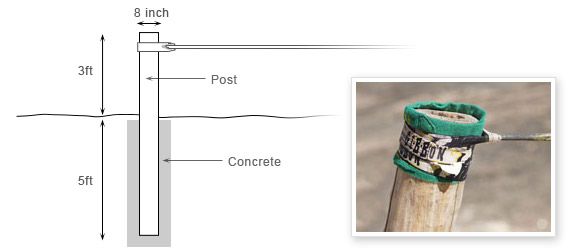
For: garden, beach etc. (places where you are permitted to install it)
Needed: digging tool, 2 rounded wooden posts (at least 8 inches in diameter and 8 feet long), concrete mix, water, spade, wheelbarrow or trough
You can even build your own posts. Dig two holes at least 5 feet deep and about twice as broad as the posts. Install the posts there, prepare concrete (watch the video below) and fill the holes with it (make sure the post is in the center of the hole).
Wait at least two days until the concrete becomes perfectly firm and you are ready. And when anchoring the line, wrap it several times around the post to prevent it from slipping (see the picture above).
Of course, if you plan to set the line more than 3 inches from the ground (for tricks for example), use thicker and longer poles (and keep the same ratio 5:3 under/above ground).
Use your car
For: almost any place
Needed: vehicle (log, A-frames)
Warning: Never use your car to actually tighten the line, you can damage it easily. Also, use this setup only for walking a short line, not for activities that involve higher forces or more tension (longer line, jumps, bounces).
There are several possibilities how to use a vehicle for slackline setup – you can anchor it to the towing shackle / ball, or you can try the wheel and log method:
Get a loop of line under the wheel (driving over it or using a car jack) and anchor it to a small piece of wood (2-4 inches on diameter is enough). Then use A-frames, plywood boxes or similar stuff to raise the line to a desired height.
Indoor
You'll probably spend most of your slackline sessions outdoors, in the nature – however, there are situations when you'll appreciate an indoor setup. For example when it's raining (on the other hand, a lot of people love slacklining in the rain ;) ), in the winter or even in your office for short relaxation pauses.
Visit your local gym / climbing center
For: tricks training for example
Needed: nothing
The most obvious choice is to check your local climbing gym – many of them offer whole areas dedicated for slacklining, or at least a possibility to rig a line there (small poles like this from slacktivity.nl are often used).
Of course, it's not as pleasant as slacklining in the nature – but great for learning new tricks because you can always get enough protective mats there (see the video below).
Expansion bolts

For: your home, office, garage, basement
Needed: 2 5/8" expansion bolts (each with 2 washers), drill, 5/8" drill bit, wrench, something for cleaning the holes + 2 A-frames (or boxes, milk crates etc.)
You wouldn't probably use this method outdoors as there exist many easier setup techniques – however, installing bolts is one of the simplest ways how to build a line in your flat, garage or even office.
Let's watch a video how to do that:
How to build A-frames for slackline
Needed: wood, screws, bolts, saw, drill
There are several manufacturers who produce A-frames dedicated to slacklining, however the price is quite high so we would rather recommend you to build your own frames. Don't worry – It's easier than it looks and you need just a few tools and some wood.
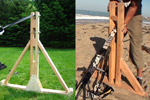
Here you can see a standard A-frame, 4×4 feet large, two slightly different designs (click on the picture to see full size).

Typically, two or three bolts are used to enable setting the line at different heights. Make sure there is enough space if you use the wider 2 inch webbing.
You can find the list of needed wooden pieces with their dimensions here (go to Step 7).
You can also see a step-by-step guide in the following videos. However, chances are you probably don’t have all those tools, so use it rather as an inspiration or reference point:




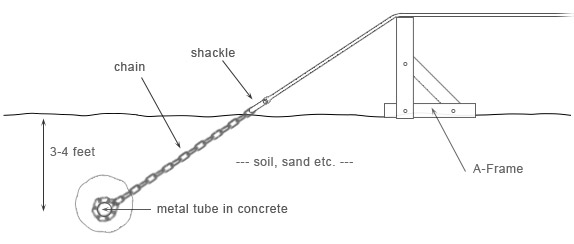
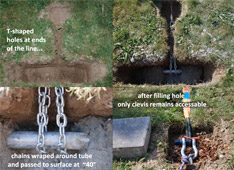





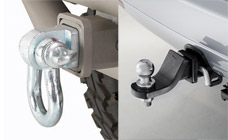







how do I access how to makean a-frame? I’m a beginner, athletic, not looking to do serious tricks,maybe somejumps. what do recommend, the classic or women’s? thanks so very much!!!
11.19.12 at 9:33 pm
hey Mitzi, I would recommend you the Classic as it’s much more universal, the Ladies line is rather for yoga, exercise or easy transport
And what do you mean by “access how to make an a-frame” please? :)
11.19.12 at 10:00 pm
Are there instructions for “How to build A-frames for slack line”?
The pics are great, but are there specific instructions?
05.21.15 at 1:21 am
Hello, take a look at https://www.youtube.com/watch?v=MVJCIckKVCM -I haven’t included this video as he’s using tools people often don’t have – but I hope it would give you an idea where to start and how to proceed :)
05.21.15 at 7:09 am
Hi, thanks for the great tips. If I use an Augar anchor, the ones they sell for slackening, is ONE anchor on each side enough for a max.10m line? And does vertical give the same strength as a 45 degree angle? I have a small garden, and a vertical anchor provides me with just a little extra meters of line ;)
10.21.15 at 12:12 pm
Hello Vic, concerning the Auger anchor it’s hard to tell, it depends on its size – I guess a big heavy-duty anchor would be enough just one for each side. And for line this short maybe even a medium sized one – it also depends if you plan to just walk or jump and bounce on it…
Concerning the vertical – you mean when the anchor is just next to the A-frame? Then the strength would be lower of course as you are pulling the anchor directly from the ground, not to the side like with the 45 degree angle. (you can think about it like pulling a nail straight from a wall versus hanging a painting on it)
10.21.15 at 2:28 pm
Slackline without trees:
stronger, faster, easyer – works even on sandbeaches!
https://youtu.be/HN_qauWngfY or http://igg.me/at/notreeslack or http://www.notreeslack.com
10.30.15 at 6:10 pm